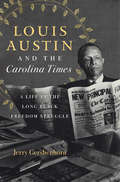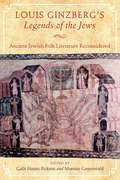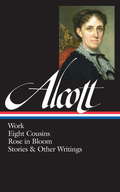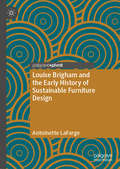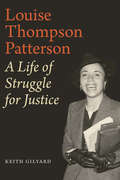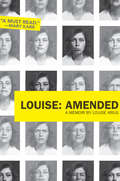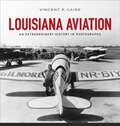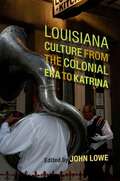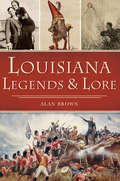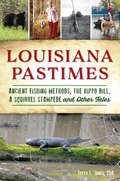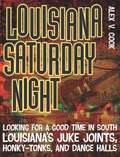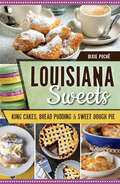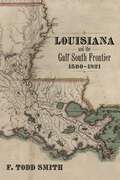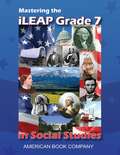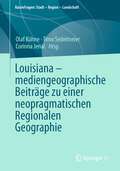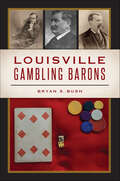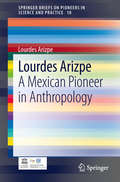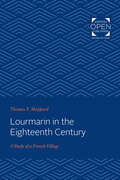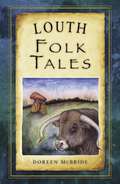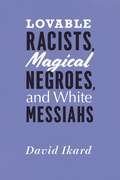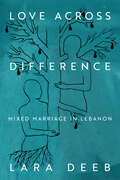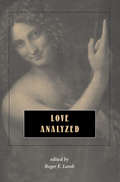- Table View
- List View
Louis Austin and the Carolina Times: A Life in the Long Black Freedom Struggle
by Jerry GershenhornLouis Austin (1898–1971) came of age at the nadir of the Jim Crow era and became a transformative leader of the long black freedom struggle in North Carolina. From 1927 to 1971, he published and edited the Carolina Times, the preeminent black newspaper in the state. He used the power of the press to voice the anger of black Carolinians, and to turn that anger into action in a forty-year crusade for freedom.In this biography, Jerry Gershenhorn chronicles Austin's career as a journalist and activist, highlighting his work during the Great Depression, World War II, and the postwar civil rights movement. Austin helped pioneer radical tactics during the Depression, including antisegregation lawsuits, boycotts of segregated movie theaters and white-owned stores that refused to hire black workers, and African American voting rights campaigns based on political participation in the Democratic Party. In examining Austin's life, Gershenhorn narrates the story of the long black freedom struggle in North Carolina from a new vantage point, shedding new light on the vitality of black protest and the black press in the twentieth century.
Louis Ginzberg's Legends of the Jews: Ancient Jewish Folk Literature Reconsidered (Raphael Patai Series in Jewish Folklore and Anthropology)
by Galit Hasan-Rokem Ithamar GruenwaldAt the beginning of the twentieth century, many perceived American Jewry to be in a state of crisis as traditions of faith faced modern sensibilities. Published beginning in 1909, Rabbi and Professor Louis Ginzberg's seven-volume The Legends of the Jews appeared at this crucial time and offered a landmark synthesis of aggadah from classical Rabbinic literature and ancient folk legends from a number of cultures. It remains a hugely influential work of scholarship from a man who shaped American Conservative Judaism. In Louis Ginzberg's Legends of the Jews: Ancient Jewish Folk Literature Reconsidered, editors Galit Hasan-Rokem and Ithamar Gruenwald present a range of reflections on the Legends, inspired by two plenary sessions devoted to its centennial at the Fifteenth Congress of the World Association of Jewish Studies in August 2009. In order to provide readers with the broadest possible view of Ginzberg's colossal project and its repercussions in contemporary scholarship, the editors gathered leading scholars to address it from a variety of historical, philological, philosophical, and methodological perspectives. Contributors give special regard to the academic expertise and professional identity of the author of the Legends as a folklore scholar and include discussions on the folkloristic underpinnings of The Legends of the Jews. They also investigate, each according to her or his disciplinary framework, the uniqueness, strengths, and weakness of the project. An introduction by Rebecca Schorsch and a preface by Galit Hasan-Rokem further highlight the folk narrative aspects of the work in addition to the articles themselves. The present volume makes clear the historical and scholarly context of Ginzberg's milestone work as well as the methodological and theoretical issues that emerge from studying it and other forms of aggadic literature. Scholars of Jewish folklore as well as of Talmudic-Midrashic literature will find this volume to be invaluable reading.
Louisa May Alcott: Work, Eight Cousins, Rose in Bloom, Stories & Other Writings
by Louisa May Alcott Susan CheeverPioneering feminist novels and rare stories from the author of Little Women: After the success of her beloved masterpiece Little Women, Louisa May Alcott brought her genius for characterization and eye for detail to a series of revolutionary novels and stories that are remarkable in their forthright assertion of women's rights. This second volume of The Library of America's Alcott edition gathers these works for the first time, revealing a fascinating and inspiring dimension of a classic American writer. The first of a trio of novels written over a fruitful three-year period, Work: A Story of Experience (1873) has been called the adult Little Women. It follows the semi-autobiographical story of an orphan named Christie Devon, who, having turned twenty-one, announces "a new Declaration of Independence" and leaves her uncle's house in order to pursue economic self-sufficiency and to find fulfillment in her profession. Against the backdrop of the Civil War years, Christie works as a servant, actress, governess, companion, seamstress, and army nurse--all jobs that Alcott knew from personal experience--exposing the often insidious ways in which the employments conventionally available to women constrain their selfdetermination. Alcott's most overtly feminist novel, Work breaks new ground in the literary representation of women, as its heroine pushes at the boundaries of nineteenth-century expectations and assumptions. Eight Cousins (1875) concerns the education of Rose Campbell, another orphan who, in her delicate nature and frail health, seems to embody many of the stereotypes of girlhood that shaped Alcott's world. But with the benefit of an unorthodox, progressive education (one informed by the theories of Alcott's transcendentalist father Bronson Alcott) and the good and bad examples of her many crisply drawn relations-- especially her seven boy cousins--Rose regains her health and envisions a career both as a wife and mother and as a philanthropist. Further advancing Alcott's passionate advocacy of women's rights, Rose insists that she will manage her own fortune rather than find a husband to do it for her. This Library of America edition includes several noteworthy features. All three novels are presented with beautifully restored line art from the original editions and are supplemented by seven hard-to-find stories and public letters (two restored to print for the first time in more than a century), an authoritative chronology of Alcott's life, and notes identifying her allusions, quotations, and the autobiographical episodes in her fiction.
Louise Brigham and the Early History of Sustainable Furniture Design
by Antoinette LaFargeDuring the Progressive Era, a time when the field of design was dominated almost entirely by men, a largely forgotten activist and teacher named Louise Brigham became a pioneer of sustainable furniture design. With her ingenious system for building inexpensive but sturdy “box furniture” out of recycled materials, she aimed to bring good design to the urban working class. As Antoinette LaFarge shows, Brigham forged a singular career for herself that embraced working in the American and European settlement movements, publishing a book of box furniture designs, running carpentry workshops in New York, and founding a company that offered some of the earliest ready-to-assemble furniture in the United States. Her work was a resounding critique of capitalism’s waste and an assertion of new values in design—values that stand at the heart of today’s open and green design movements.
Louise Thompson Patterson: A Life of Struggle for Justice
by Keith GilyardBorn in 1901, Louise Thompson Patterson was a leading and transformative figure in radical African American politics. Throughout most of the twentieth century she embodied a dedicated resistance to racial, economic, and gender exploitation. In this, the first biography of Patterson, Keith Gilyard tells her compelling story, from her childhood on the West Coast, where she suffered isolation and persecution, to her participation in the Harlem Renaissance and beyond. In the 1930s and 1940s she became central, along with Paul Robeson, to the labor movement, and later, in the 1950s, she steered proto-black-feminist activities. Patterson was also crucial to the efforts in the 1970s to free political prisoners, most notably Angela Davis. In the 1980s and 1990s she continued to work as a progressive activist and public intellectual. To read her story is to witness the courage, sacrifice, vision, and discipline of someone who spent decades working to achieve justice and liberation for all.
Louise: A Memoir
by Louise Krug"A massive brain trauma robbed fashionable young Louise of the shallow currency she'd banked on all her life, and the resulting struggle is a page-turner in which a person's very soul deepens before your eyes. Louise: Amended rewards a reader's time-a must read."-Mary KarrA beautiful young woman from Kansas is about to embark on the life of her dreams-California! Glossy journalism! French boyfriend!-only to suffer a brain bleed that collapses the right side of her body, leaving her with double vision, facial paralysis, and a dragging foot. An unflinching, wise, and darkly funny portrait of sudden disability and painstaking recovery, the memoir presents not only Louise's perspective, but also the reaction of her loved ones-we see, in fictional interludes, what it must have been like for Louise's boyfriend to bathe her, or for her mother to apply lipstick to her nearly immobile mouth. Challenging the notion that one person's tragedy is a single person's story, Louise: Amended depicts a dismantling-and rebirth-of an entire family.At age twenty-two, Louise Krug suffered a brain bleed and underwent an emergency craniotomy that disrupted her ability to walk, see, and move half her face. Now, six years later, Louise has astounded doctors and loved ones by recovering not only much of her vision and mobility, but a ferocious spirit and enviable grace. She currently lives with her husband Nick and daughter Olive in Lawrence, Kansas, where she's a PhD candidate and teacher.
Louisiana Aviation: An Extraordinary History in Photographs
by Vincent P. CaireAt the beginning of the twentieth century the skies presented a new frontier, one that attracted daredevils, businessmen, politicians, and engineers enticed by a new form of transportation. Louisiana entrepreneurs and pilots proved instrumental in ushering in the Golden Age of Aviation. They advanced aircraft design, revolutionized aerial crop dusting, pioneered airmail routes, pushed the limits of stunt flying, and entertained spectators with air races. A pilot and freelance writer with more than twenty years of experience in the aviation industry, Vincent P. Caire chronicles the state's history of flight in 196 vintage and contemporary photographs, many never-before published. Photos of early aviation pioneer John Moisant, air racing champion General James Doolittle, barnstormer Roscoe Turner, aircraft designer James Wedell, and founder of Delta Airlines C. E. Woolman reflect Louisiana's zeal for aeronautics. Caire explains how the efforts of Senator Huey P. Long and Harry P. Williams, co-owner of the Wedell-Williams Air Service in Patterson, Louisiana, influenced the development of viable airmail routes throughout the southeastern United States. Rarely seen photographs depict the Art Deco elegance of the first modern, multioperational passenger terminal in the nation -- Shushan Airport in New Orleans.A captivating visual tour spanning one hundred years, Louisiana Aviation celebrates the state's air history, evident in Louisiana's seventy airports, 5,000 aircraft, 7,000 pilots, and numerous airshows in operation today.
Louisiana Culture from the Colonial Era to Katrina (Southern Literary Studies)
by John LoweIn 1803, President Thomas Jefferson acquired 828,000 square miles of French territory in what became known as the Louisiana Purchase. Although today Louisiana makes up only a small portion of this immense territory, this exceptional state embraces a larger-than-life history and a cultural blend unlike any other in the nation. Louisiana Culture from the Colonial Era to Katrina, a collection of fourteen essays compiled and edited by John Lowe, captures all of the flavor and richness of the state's heritage, illuminating how Louisiana, despite its differences from the rest of the United States, is a microcosm of key national concerns -- including regionalism, race, politics, immigration, global connections, folklore, musical traditions, ethnicity, and hybridity. Divided into five parts, the volume opens with an examination of Louisiana's origins, with pieces on Native Americans, French and German explorers, and slavery. Two very different but complementary essays follow with investigations into the ongoing attempts to define Creoles and creolization. No collection on Louisiana would be complete without attention to its remarkable literary traditions, and several contributors offer tantalizing readings of some of the Pelican State's most distinguished writers -- a dazzling array of artists any state would be proud to claim. The volume also includes pieces on a couple of eccentric mythologies distinct to Louisiana and explorations of Louisiana's unique musical heritage.Throughout, the international slate of contributors explores the idea of place, particularly the concept of Louisiana as the center of the Caribbean wheel, where Cajuns, Creoles, Cubans, Haitians, Jamaicans, and others are part of a New World configuration, connected by their linguistic identity, landscape and climate, religion, and French and Spanish heritage. A poignant conclusion considers the devastating impact of Hurricanes Katrina and Rita and what the storms mean for Louisiana's cultural future. A rich portrait of Louisiana culture, this volume stands as a reminder of why that culture must be preserved.
Louisiana Legends & Lore (American Legends)
by Alan BrownLean back into Louisiana lore with an earful of New Orleans jazz and a bellyful of Cajun cuisine. But when the music dies down and the lights flicker out, hushed conversations bleed into the darker mysteries of the Pelican State. Storied outlaws like John Murrell, Eugene Bunch and Leather Britches Smith steal into the room. Voodoo priestesses Marie Laveau and Julia Brown are already there, along with the Phantom Whistler and the Axeman of New Orleans. Folklorist Alan Brown educates and entertains with tales of the unseemly, bizarre and otherworldly, like the legends of the Rougarou, the Lutin and the Honey Island Swamp Monster.
Louisiana Pastimes: Ancient Fishing Methods, the Hippo Bill, a Squirrel Stampede and Other Tales
by Terry L. Jones PhDFew states can match Louisiana in terms of rich history, colorful characters and strange occurrences. It was home to America's first mound builders, the birthplace of the nation's modern army and the scene of a dismaying number of natural disasters. Louisiana's story also includes the weird and bizarre. Fish and worms have rained from the sky, sea serpents have been spotted off its coast and Bigfoot is said to roam the woods. From stampeding squirrels and bayou hippos to Native American hunters and sunken galleons, this collection of tales will entertain anyone who enjoys outdoor adventures and offbeat history. Award-winning author Dr. Terry L. Jones has tapped into his broad knowledge of Louisiana and his own outdoor experiences to produce this engaging book.
Louisiana Saturday Night: Looking for a Good Time in South Louisiana's Juke Joints, Honky-Tonks, and Dance Halls (Southern Messenger Poets)
by Alex V. CookFrom backwoods bars and small-town dives to swampside dance halls and converted clapboard barns, Louisiana Saturday Night offers an anecdotal history and experiential guidebook to some of the Gumbo State's most unique blues, Cajun, and zydeco clubs. Music critic Alex V. Cook uncovers south Louisiana's wellspring of musical tradition, showing us that indigenous music exists not as an artifact to be salvaged by preservationists, but serves as a living, breathing, singing, laughing, and crying part of Louisiana culture. Louisiana Saturday Night takes the reader to both offbeat and traditional venues in and around Baton Rouge, Cajun country, and New Orleans, where we hear the distinctive voices of musicians, patrons, and owners -- like Teddy Johnson, born in the house that now serves as Teddy's Juke Joint. Along the way, Cook ruminates on the cultural importance of the people and places he encounters, and shows their critical role in keeping Louisiana's unique music alive. A map, a journal, a snapshot of what goes on in the little shacks off main roads, Louisiana Saturday Night provides an indispensable and entertaining companion for those in pursuit of Louisiana's quirky and varied nightlife.
Louisiana Sweets: King Cakes, Bread Pudding, & Sweet Dough Pie (American Palate Ser.)
by Dixie PochéExplore the recipes and history behind an array of sweet treats from the Sugar State with help from the author of Classic Eateries of Cajun Country.Louisiana is famous for its culinary delights, and the state&’s rich medley of treats and confections proves its sweet tooth. Creative bakers improvised traditional recipes during days of rationing to create gateau de sirop (syrup cake) and bread pudding. Early customers of Lea&’s Lunchroom&’s pies in central Louisiana included outlaws Bonnie and Clyde, who dropped by while they were on the run. During the 1950s, singers Hank Williams Sr. and Elvis Presley hung out at Shreveport&’s Southern Maid Donuts after performing at the popular Louisiana Hayride country music broadcast. Author Dixie Poché dives into the recipes and history behind such beloved regional specialties as Mardi Gras king cake, flaming Bananas Foster, Cajun Country&’s pain perdu and many more.&“Desserts Past, Present, and Future are the stars of Dixie Poché&’s new book, Louisiana Sweets: King Cakes, Bread Pudding, and Sweet Dough Pie. The Lafayette-based travel writer gets rather Dickensian (but trade that tacky soot for powdered sugar) as she lays outs a picture of the state&’s love affair with sweets through history, anecdotes, recipes, restaurant profiles, and more.&” —Country Roads Magazine
Louisiana and the Gulf South Frontier, 1500-1821
by F. Todd SmithBound together by social, demographic, and economic commonalities, the territory extending from East Texas to West Florida occupies a unique space in early American history. A masterful synthesis of two decades of scholarly work, F. Todd Smith's Louisiana and the Gulf South Frontier, 1500-1821 examines the region's history from the eve of European colonization to the final imposition of American hegemony.The agricultural richness of the Gulf Coast gave rise to an extraordinarily diverse society: development of food crops rendered local indigenous groups wealthier and more powerful than their counterparts in New England and the West, and white demand for plantation slave labor produced a disproportionately large black population compared to other parts of the country. European settlers were a heterogeneous mix as well, creating a multinational blend of cultures and religions that did not exist on the largely Anglo-Protestant Atlantic Coast.Because of this diversity, which allowed no single group to gain primacy over the rest, Smith's study characterizes the Gulf South as a frontier from the sixteenth century to the early years of the nineteenth. Only in the twenty years following the Louisiana Purchase did Americans manage to remove most of the Indian tribes, overwhelm Louisiana's French Creoles numerically and politically, and impose a racial system in accordance with the rest of the Deep South.Moving fluently across the boundaries of colonial possessions and state lines, Louisiana and the Gulf South Frontier, 1500-1821 is a comprehensive and highly readable overview of the Gulf Coast's distinctive and enthralling history.
Louisiana iLeap 7th Grade Social Studies
by Kindred Howard Katie HermanLouisana iLEAP Social Studies Test in Grade 7 Test Preparation
Louisiana – mediengeographische Beiträge zu einer neopragmatischen Regionalen Geographie (RaumFragen: Stadt – Region – Landschaft)
by Olaf Kühne Corinna Jenal Timo SedelmeierDer ‚Pelican State‘ weist mit den Sümpfen und Bayous wie auch seinen Vorkommen an Erdgas und Erdöl eine sehr spezifische naturräumliche Ausstattung auf, er ist in Teilen – insbesondere in seinem Süden – gegenüber den Folgen des anthropogenen Klimawandels sehr vulnerabel, historisch ist ihm eine wechselvolle Geschichte eigen. Insofern eignet er sich für die geographische Forschung in besonderer Weise für eine synthetisierende Betrachtung, in der ‚neopragmatisch‘ unterschiedliche theoretische Ansätze in Hinblick auf ‚Raum‘ zum Tragen kommen. In dem vorliegenden Band fokussieren sich die Autorinnen und Autoren dabei auf die medialen Repräsentanzen Louisianas. Begründet ist dies in der großen Bedeutung von (Massen)Medien für die soziale Konstruktion von Wissen, Deutungen und Wertung, in diesem Fall von Raum.
Louisville Gambling Barons (The History Press)
by Bryan S. BushThe Golden Age of Gambling in Louisville Louisville experienced a golden age of gambling between 1860 and 1885, thanks to the arrival of hundreds of thousands of Union soldiers by steamboat and foot. They played faro, keno, roulette and other games of chance, such as chuck-a-luck. Entire city blocks were devoted to betting. Horse racing and lotteries emerged. Gaming houses became grand palaces, with names such as the Crockford, the Crawford and the Turf Exchange, frequented by famous gamblers like Richard Watts, Colonel "Black" Chinn and actor Nat Goodwin. Author Bryan Bush offers up these stories and more about "The City of Gamblers."
Lourdes Arizpe
by Lourdes ArizpeThis book presents major texts by Prof. Dr. Lourdes Arizpe Schlosser, a pioneering Mexican anthropologist, on the occasion of her 70th birthday. She is a leading researcher into indigenous peoples, an innovator in women's studies and a global scientific leader who has inspired the international research and policy communities. Throughout her distinguished career she has analysed ethnicism and indigenous peoples, women in migratory flows, cultural and social sustainability and intangible cultural heritage as social capital, placing these issues on the world agenda for research and policy. Several of the 12 major texts in this volume have been published since 1972 in the US, Europe, Latin America and India; some were first published in Spanish and are available in English for the first time. This anthology also includes recent unpublished texts on culture, development and international cultural policy delivered at high-level international meetings.
Lourdes: Body And Spirit in the Secular Age
by Ruth HarrisLourdes was at the very centre of nineteenth century debates on religion, science and medicine. Both the Church and secularists championed the 'miracle' town as crucial in shaping how society should think about the mind, body and spirit. Since the ‘visions’ of Bernadette Soubirous in 1858 transformed the quiet Pyrenean town into an international tourist and pilgrimage destination, it has been a site for controversy. In her well-crafted and carefully researched book, Harris deftly places Lourdes and its attendant spiritual movement firmly at the centre of French history and shows its significance in the country’s development.
Lourmarin in the Eighteenth Century: A Study of a French Village (The Johns Hopkins University Studies in Historical and Political Science)
by Thomas F. SheppardOriginally published in 1971. In the 1970s, social historians of seventeenth-century France began examining the social changes in the ancien régime in an effort to reconstruct the events leading up to the French Revolution. Thomas Sheppard examines Lourmarin, a mainly Protestant village with a small textile industry. He seeks to answer a series of questions posed at the outset of the book: What was daily life like in an eighteenth-century French village? How was village government organized? To what extent did community leaders regulate village political life? What effect did the Revolution have on life in the village? Sheppard answers these questions with his archival work in Lourmarin. He concludes his work with an investigation of the effects of the Revolution on life in Lourmarin following 1789.
Louth Folk Tales
by Doreen McBrideCatch a glimpse of the spirit of Ireland in the entertaining company of professional storyteller Doreen McBride as she recounts the local tales, ancient and modern, of County Louth. You will hear of the doomed love of Lassara and her harpist who haunt the waters of Carlingford Lough, of the origin of the River Boyne and of the jumping church at Kildemock. You will also discover St Brigid’s association with Faughart, how the Hound of Ulster recovered from war wounds on the Death Mound of Du Largy, and where you might find leprechaun gold. And on the way you will encounter a killer cat, a fairy horse and the Salmon of Knowledge – as well as some talkative toes. From age-old legends and fantastical myths, to amusing anecdotes and cautionary tales, this collection is a heady mix of bloodthirsty, funny, passionate and moving stories. It will take you into a remarkable world where you can let your imagination run wild.
Lovable Racists, Magical Negroes, and White Messiahs
by T. Denean Sharpley-Whiting David IkardIn this incredibly timely book, David Ikard dismantles popular white supremacist tropes, which effectively devalue black life and trivialize black oppression. Lovable Racists, Magical Negroes, and White Messiahs investigates the tenacity and cultural capital of white redemption narratives in literature and popular media from Uncle Tom’s Cabin to The Help. In the book, Ikard explodes the fiction of a postracial society while awakening us to the sobering reality that we must continue to fight for racial equality or risk losing the hard-fought gains of the Civil Rights movement. Through his close reading of novels, films, journalism, and political campaigns, he analyzes willful white blindness and attendant master narratives of white redemption—arguing powerfully that he who controls the master narrative controls the perception of reality. The book sounds the alarm about seemingly innocuous tropes of white redemption that abound in our society and generate the notion that blacks are perpetually indebted to whites for liberating, civilizing, and enlightening them. In Lovable Racists, Magical Negroes, and White Messiahs, Ikard expertly and unflinchingly gives us a necessary critical historical intervention.
Love Across Difference: Mixed Marriage in Lebanon
by Lara DeebLebanon may be the most complicated place in the world to be a "mixed" couple. It has no civil marriage law, fifteen personal status laws, and a political system built on sectarianism. Still, Lebanon has the most interreligious marriages per capita in the Middle East. What constitutes a mixed marriage is in flux as social norms shift, and reactions to mixed marriage reveal underlying social categories of discrimination. Through stories of Lebanese couples, Love Across Difference challenges readers to rethink categories of difference and imagine possibilities for social change. Drawing on two decades of interviews and research, Lara Deeb shows how mixed couples in Lebanon confront patriarchy, social difference, and sectarianism. In the drama that ensues as women and young men make their own marital choices, they push gender boundaries and reveal the ultimately empty nature of sect as a category of social difference. Love won't end sectarianism, but it can contribute to reducing sect's social power. Through the example of Lebanon, we can learn about our own social worlds, about the assumptions we make around social difference, and about how people react when forced to change their ideas of who can be made kin through marriage.
Love Analyzed
by Roger E. LambPhilosophers have turned their attention in recent years to many previously unmined topics, among them love and friendship. In this collection of new essays in philosophical and moral psychology, philosophers turn their analytic tools to a topic perhaps most resistant to reasoned analysis: erotic love. Also included is one previously published paper by Martha Nussbaum.Among the problems discussed are the role that qualities of the beloved play in love, the so-called union theory of love, intentionality and autonomy in love, and traditional issues surrounding jealousy and morality.
Love Behind Bars: The True Story of an American Prisoner's Wife
by Jodie SinclairThe Powerful, Poignant Story of Love, Courage, and Redemption from Death Row, Where an Indomitable Woman Challenged Corruption in Order to Free her Husband When TV reporter Jodie Sinclair went to the Louisiana State Penitentiary, also known as the Death House at Angola, in 1981, she expected to report about the death penalty and leave. She never expected to fall in love. Billy Sinclair was an inmate at Angola, sent there for an accidental murder during a robbery gone wrong. After facing a trial which was skewed against him and being sentenced to death, he saw first-hand the corruption and abuse rife in the criminal justice system, and he began an unrelenting crusade for reform. When the pair married by proxy a year after meeting, Jodie took up Billy&’s fight. From then on, she lived with one foot in the outside world and one in the complex and dehumanizing bureaucracy of the prison world. This incredible memoir tracks her heroic twenty-five-year fight to save her husband from dying in prison, the professional setbacks she suffered for marrying a prisoner, and a pardons scandal in which she wore a wire for the FBI to help her husband expose corruption in the criminal justice system leading all the way to the governor's office, which put a target on Billy's back. It is the uplifting true story of a woman who stood by her man, and in doing so, exposed the horrors of our criminal justice system and became a voice for all those who have loved ones behind bars.
